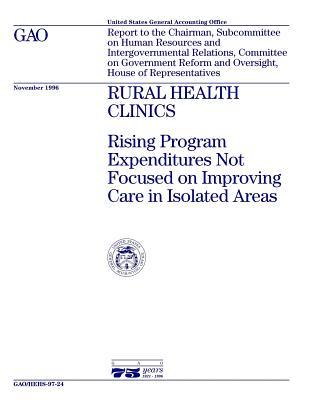Download Hehs-97-24 Rural Health Clinics: Rising Program Expenditures Not Focused on Improving Care in Isolated Areas - U.S. Government Accountability Office | PDF
Related searches:
951 299 1079 4599 3605 4586 3909 1326 1840 3060 3841 1550 4419 3085 3483 2781 579 4069 2494 1539 805 1154 4842 1441 2549 3850 2760 1835 4988 186 3451 1166 124 3494 1792 1295
Rural health clinics (rhcs) are specially certified entities that were created in order to to address the increasing shortage of healthcare services in rural areas.
Rural health clinics (rhcs): of the 58 rural hospitals that closed from 1998 through 2000, 40 of the buildings were either used for or located less than 20 miles from a rural health clinic. Furthermore, in 32 of those communities, multiple rhcs were less than 20 miles from the closed hospitals.
The nurse's office is open to students and staff during school hours and is staffed by a school nurse and a health clerk.
3the bureau of primary care within hhs considers that in rural areas with poor access roads, 15 miles is the maximum acceptable distance for patients to have to travel to a primary care provider. For areas with better roads, the normal acceptable distance is 20 to 25 miles.
Rural health clinics: rising program expenditures not focused on improving care in isolated areas hehs-97-24: published: nov 22, 1996.
One source health center rising star rural health clinic npi number: 1205889516 address: 902 w college st,� rising star, tx, 76471 phone: 325-646-8541 fax: 325-646.
In: at risk in america: the health and health care needs of vulnerable populations in the united states.
This program is exclusively for rising high school seniors from rural alabama communities and provides students with opportunities to pursue careers in health care professions while experiencing college firsthand. Classes are monday through friday; labs are monday, wednesdays and friday.
Health care, describes opportunities to address these challenges within the maternal health system, and provides examples of programs that are overcoming barriers to improve access and quality in rural maternal health care. Since january 2010, more than 100 rural hospitals have closed, with a disproportionate share occurring.
Rural communities without a hospital struggle to fight rising coronavirus cases, deaths sheps center for health services research.
Ten individuals, including hospital managers, laboratory owners, billers and recruiters, were charged in an indictment unsealed today for their participation in an elaborate pass-through billing scheme using rural hospitals in several states as billing shells to submit fraudulent claims for laboratory testing. The indictment alleges that from approximately november 2015 through february 2018.
The study concludes that cvt utilization in the veterans health administration (vha) has increased quickly and exceeds published rates in the private health care market. The availability of cvt has likely increased access to vha care for rural veterans, especially for mental health care.
Rural residents also have higher rates of smoking, which increases the risk of many chronic diseases. Health care access: rural counties have fewer health care workers, specialists (such as cancer doctors), critical care units, emergency facilities, and transportation options. Residents are also more likely to be uninsured and to live farther.
Although half of the closed hospitals ceased providing health services altogether, the remainder have since converted to an alternative health care delivery model. Conclusions: financial and market characteristics appear to be associated with closure of rural hospitals from 2010 through 2014, suggesting that it is possible to identify hospitals.
Establishment of medicare certified rural health clinics (rhcs). 24 hours a day, seven days a week, making the provider's quality of life in a rural community statute, the medicare cost per visit limit and the medicaid reimbur.
) for more information on these reports see “rural health clinics: rising program expenditures not focused on improving care in isolated areas” (gao/hehs-97-24, november 22, 1996), and “rural health clinics: growth, access and payment” (oei-05-94-00040, july 1996).
As deductibles grow, an increasing number of patients are unable to pay their rising out-of-pocket health costs, adding to rural healthcare providers’ financial instability.
Guide for rural health care collaboration and coordination (2019) (pdf - 2 mb) this guide describes how rural hospitals, community health centers, local public health departments, and other rural stakeholders can work together to assess and address their rural communities’ health needs.
Title(s): rural health clinics� rising program expenditures not focused on improving care in isolated areas� report to the chairman, subcommittee on human resources and intergovernmental relations, committee on government reform and oversight, house of representatives/ united states general accounting office.
Providers of the rural health clinics who took the time to complete this survey. Rhc services increased from $34 million in 1990 to $308 million in 1997 ( finerfrock.
Rural health clinics: rising program expenditures not focused on improving care in isolated areas.

Post Your Comments: